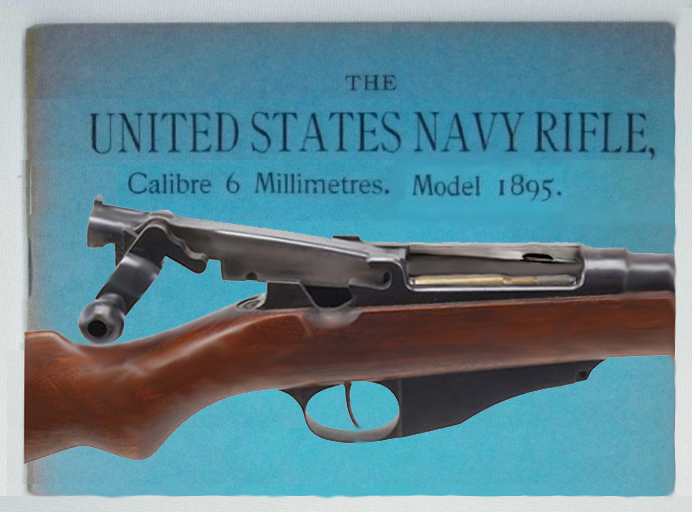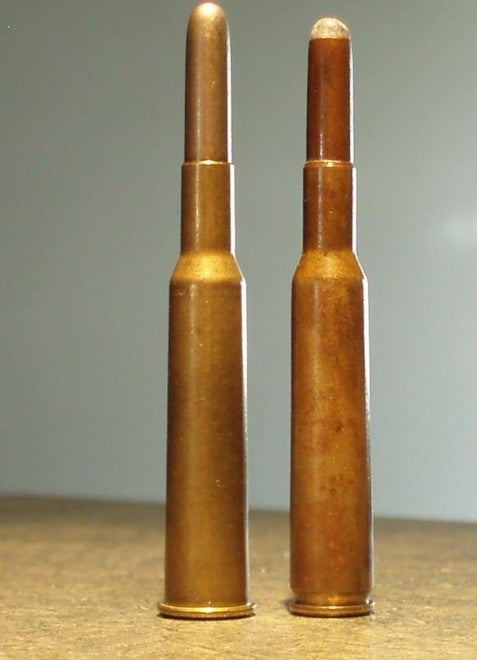

One of the first truly multipurpose rifles designed by collaboration of Remington Arms Co., British gun designer James Paris Lee, and the US Dept. Of Ordnance, and underwent official production in 1895, this successor to the Remington-Lee M-1885 Navy utilized a straight pull cam action bolt design whose mechanism had been required to be rated for at least 60,000 PSI of pressure in a proof load, as established by the US Navy, who became the primary purchaser of the new rifle. The Dept. Of Ordnance also standardized the caliber for the Browning 1895 machine gun in the new 6mm cartridge as well, using the same pressure, propellant, bullet weight, and velocity, enabling infantrymen to strip cartridges off of the machine gun's loaded belts for use in their rifles should the need arises.
The 6mm Lee cartridge:

Using a 112 to 120 grain copper jacketed 'ball' round at over 2,550 FPS with the newly developed nitrocellulose "Rifleite" powder, the 6mm Lee was the US Armed Forces first successful smokeless powder battle rifle cartridge. And it's velocity of over 2,550 FPS was considered the highest achieved by any available cartridge of the day. The cartridge itself had been noted by many observers to resemble the 'tip of a mechanical pencil', as the casing is necked down to accept a thin and highly elongated slug at it's front. Highly accurate and powerful, US Model 1895 rifles chambered in this cartridge became the primary combat long gun of the US Marines from 1895 to 1907. Many rifles also went to the Army, where they were especially favored amongst marksmen for it's flat shooting performance. During the Siege of Beijing in 1900, at the height of the Boxer Rebellion in China, US Marine snipers dispatched to the front lines to help relieve the besieged foreign concessions in the Chinese capital city faced off against their Chinese counterparts who wielded the Hanyang Type-88 rifle, chambered in the soon to be legendary 7.92x57 Mauser cartridge and boasting the already vaunted and combat proven Mauser action. As the battle raged, some engagements between the opposing forces reached distances of more than 1000 yards, and men began to fall on both sides as a devastating fire began to sweep through the besieged region. Over the course of the battle, the Marine sharpshooters' training and experience paid off, and soon the Chinese riflemen withdrew, allowing the Marines to rescue the survivors in the concession zone before the structures succumbed to the inferno. The M1895 Lee also saw service in the Spanish American conflict and the subsequent Moro guerrilla wars.
During it's period of service, it was quickly found out to the dismay of armorers that the barrels of the M1895 had been prone to wearing out just after several hundred rounds fired due to the high velocity and pressure of the 6mm cartridge. Despite immediate measures taken to reline and build new barrels with a nickel-steel bore liner which extended the guns' service lives to several thousand rounds, the Dept. Of Ordnance began to phase out the remaining M1895's from service in 1898 for the .30-40 Krag Jorgensen. However, some units continued to field the M1895 Lee well into the twentieth century, relying upon it's extraordinary accuracy and strength of it's straight pull system. The 6mm Lee represents the very first of the high velocity smallbore calibers which will explode in popularity by the middle of the 20th century as metallurgy and firearms designs improved.


